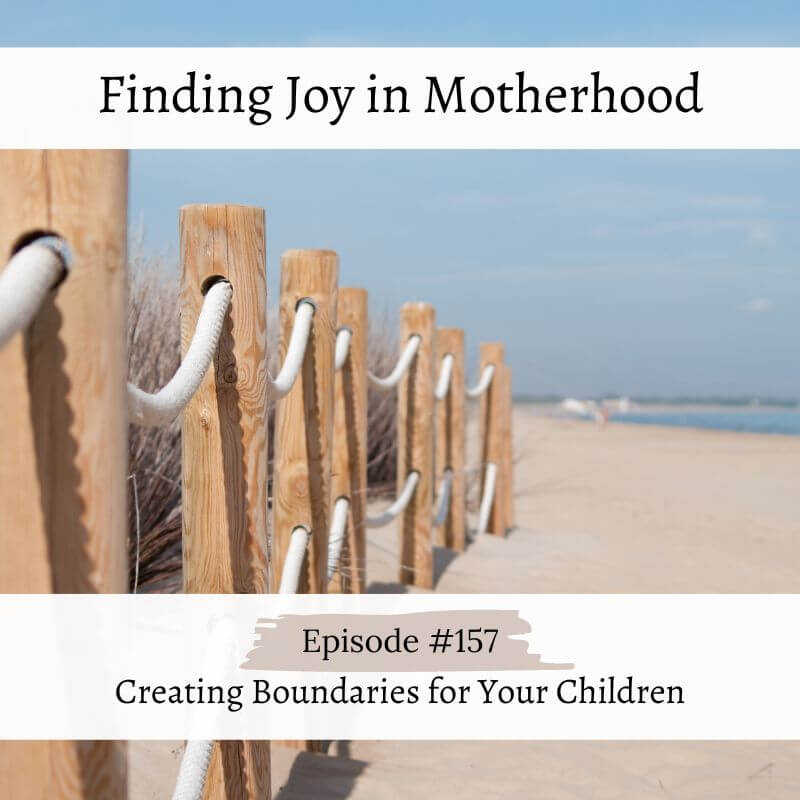Subscribe:
Like What You Hear and Want More?
Find out more about Reimagine Motherhood, my monthly coaching program. I give practical tools and help you make mindset shifts to create the marriage, motherhood, and home you’ve always wanted.
Notes From This Episode
Background
- Boundaries or guardrails are limits on a child’s behavior.
- Our children look to us to know what the limits are. They do not have a developed prefrontal cortex that helps them think – they just do, and they do not know what they should and shouldn’t be doing.
Why Set Boundaries?
- Setting boundaries helps our children learn how to live in an adult world.
- Boundaries help our children feel secure because they understand what they can and cannot do.
Boundary Development
- When children are young, they do not have agency over their emotions or actions, so we set the guardrails close.
- As your children grow and mature in responsibility, we begin to widen the guardrails or boundaries according to their capacity to be responsible.
Responsibility and Freedom
- Children lose respect for adults who cannot set limits and stick to them.
- If you think you are being nice to your children by not setting boundaries, you are, instead, showing your children that you are weak and unkind.
- When you do not teach them the boundaries, you do not show them the limits or even that there are limits that need to be followed.
- When we set firm limits or boundaries, our children develop self-esteem.
- Children without limits suffer from low self-esteem and will behave accordingly.
- They will act any way they want, and then we respond with anger, annoyance, frustration, etc.
Boundaries Teach Virtue
- If you have the boundary of not hitting siblings, it helps your children grow in respect for others.
- Boundaries in the way your children dress teaches modesty.
- Playing nicely with others teaches generosity.
- Boundaries in the way they eat teaches moderation.
- When we set the boundary to respond to our requests, we teach obedience and justice.
Temper Tantrums
- There is a lot of talk about allowing a temper tantrum to run its course and not address it.
- Ignoring a temper tantrum sets the precedent that temper tantrums are acceptable behavior.
- We have to help our children understand what acceptable behavior is, and a temper tantrum is unacceptable behavior.
- This does not mean we do not help our children process their emotions, but we do not process the feelings by letting them behave anyway they choose.
- We have to help our children understand what acceptable behavior is, and a temper tantrum is unacceptable behavior.
Where to Set Boundaries
- Sleep
- Have a set bedtime and a set get-up time, and teach your children that just because they are awake, does not meant they have to get up.
- Routines and habits
- Children need to have certain morning routines, which consist of habits done before they can do anything else.
- Food
- Children cannot eat whatever they want, whenever they want, and wherever they want.
- Have clear meal and snack times, and teach your children they cannot eat whatever they want.
- Playing with others
- Setting this boundary teaches your children to respect other people and to ensure they are being respected.
- Help your children establish boundaries for themselves in the way they treat others and in the way others treat them.
- Speech
- Children should not be allowed to disrespect their parents. Remember, you are creating boundaries for their behavior of who they are going to be as adults.
- Personal Space
- Children should learn they cannot always demand attention.
- When mom or dad is speaking to another person, they need to wait quietly. Just because they want your attention, does not mean they get it automatically.
Ways to Create Boundaries
- Say what you mean and mean what you say.
- This is the foundation of parenting.
- You need to know why you have the boundary and what the consequences will be for breaking it. And you need to communicate that to your child.
- Continue to enforce the boundary and follow through calmly and be consistent and strong.
- Children feel the most secure around parents who are strong, not mean and authoritative.
- Remember, freedom according to responsibility.
- You may need to pull the boundaries back if your children are not being responsible with their freedom.
- Then, as they show more responsibility, they can regain that freedom.
Final Thoughts
- Setting boundaries for your children is an act of love.
- Do not let your children decide how an adult should behave. They have no idea, and it is your job to teach them.
- Boundaries help children learn how to set limits for themselves and develop self-discipline, which in turn contributes to their self-esteem.

